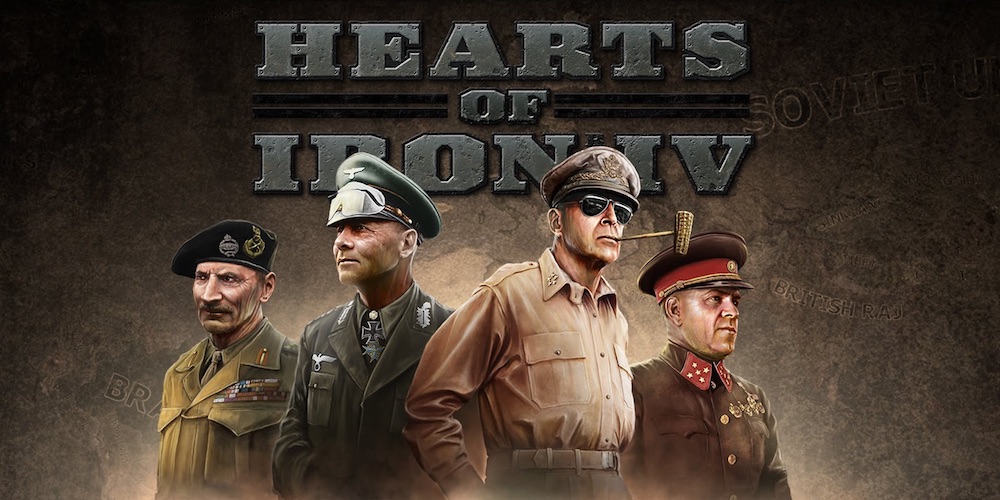
It’s a given that strategy games are more complicated than other genres. They’re more demanding on a player to know what’s going on and how to respond, and their unforgiving nature doesn’t help the accessibility. But, hey, to hell with casuals, am I right? We’ve got Hearts of Iron IV, the fourth game in what is undoubtedly the most intimidating strategy game series I can think of. I couldn’t get into Hearts of Iron 3, and holy balls, Hearts of Iron IV isn’t much easier, but I’m tempted to fail my exams just to figure out how any of this shit works.
HoI4 is a WW2 quasi-simulation grand strategy game, which you can say three times fast immediately to grow a pair of mighty war-faring testicles. The idea of the game is to control a nation around the period of that large, historical war people sometimes mention. The aim isn’t really to win per se but rather to see what happens and what influences you can make. What would happen if France became glorious Commies? If Switzerland weren’t neutral? If the Soviets dominated The East? It’s a game of toying with history, but history isn’t a simple thing.

To call Hearts of Iron complex would be like calling Hitler a tool. Fitting, perhaps, but the description doesn’t adequately capture the scale of the matter. I’ve put 8 hours into this game (it would have been more, but E3 and uni exams crept up on me a bit like those damn French), and I still have no clue what I’m doing. You need to manage your logistics, including supply chains for your troops, with so much forethought that I could barely decide on what to do next. On top of that, you’re in control of your country’s direction, managing diplomatic relations and directing your armies to become the one true king. There’s a lot to manage, and while it’s still mind-boggling in scale, HoI4 is much more accessible than previous entries in the series.
When you first hop into the game, there’s a short guided tutorial, which is more than could be said for other HoI games. It reminded me of Stellaris’ tutorial, except Stellaris didn’t have everything unlocked from the get go, so players could gradually run into the mechanics as the game played out. HoI4’s tutorial is more like Total War: Warhammer’s where everything is unlocked from the beginning, but that’s not a good thing. If you don’t already know what’s coming later down the line (because who paid attention in History!?), you’re going to neglect potentially crucial mechanics because didn’t know they existed yet. The UI is better than HoI3, though, but it’s not outstanding by any means.

The biggest reason why HoI4 is more approachable than previous entries is the UI. Instead of taking the player to different screens to deal with various topics, the game is played with the world map constantly in view. This means that if you’re sorting out what divisions you want to recruit next, you don’t need to switch between the map and the recruitment screen to make an informed decision. The only screens that take you away from the map are the research and national focus trees, but they’re well laid out and don’t have much need for the world map. So, how could a UI that involves seeing the world map at all times backfire? When you can’t find what you want, funnily enough.
While the interface is a step up, there are plenty of examples of issues that have been overlooked. The biggest one is noticeable notifications, which sounds hard to mess up, but when the icon is the size of a toenail, it doesn’t live up to its namesake. On the other side of the spectrum, air management is an absolute nightmare, and it will take up most of your screen very quickly, but I’ll come back to that later. Even little things have been overlooked, like coloured buttons, so you’ll spend a lot of time fussing about if you’re not intimate with the UI. Thankfully, once you figure it out, it’s not hard to start planning out your grand strategy.

Part of your world plan will involve moving your units, and HoI4 does things both excellently and counter-intuitively. For land units, you can draw out frontlines for the AI to execute later down the line, removing a lot of micromanagement from large scale battles. You also set up your air units in vast regions to ensure air superiority, but doing this involves trawling through pop-ups of airfields to transfer groups of planes. It’s an inelegant system that creates an enormous amount of clutter, and compared to the refinement of the logistics side of the game, it’s a frustrating interface to cope with.
It might seem like I’m focusing on the menus a great deal, and because that’s where I spend 80% of my time, it’s where most of my problems lie. The game itself, while utterly impenetrable, is satisfying to engage in, but even after this long of playing it, I have no idea what I’d do next time. If there’s any way to play the game, it’s to go in with a plan and see how well you can pull it off. However, if you’re willing to spend a few days getting into the minutia of the system, one that has persisted to its 4th title now, you definitely can. Thankfully, this iteration of the game has taken us into the exciting 3rd dimension, and it’s a welcome change.

Moving from 2D into 3D makes a surprisingly big difference in the games you play, which sounds way more apparent than it should. The old HoI games displayed units as rectangles with icons in them, and while this still happens when you zoom out, you can now zoom in for a nice look at whether you’re up against mainly infantry or tanks. The terrain is a lot easier to read too, since you’re not checking whether a province is hilly since you can just see if it has hills, much like seeing hills in real life as an ethereal orb commander. The only major problem with the game from a presentation perspective is how it lacks any form of customisation.
While the camera and interface nail it most of the time, there’s no way to change when particular things happen. For instance, when you zoom out to a given level, the names of the countries will appear in their respective coloured regions. There’s no way to change at what point this occurs, if at all, so I can’t keep that feature on even when I’m zoomed right in on a country. You even need to switch map modes to keep information about supply or air superiority on screen. To me, that’s a let down I wasn’t expecting to have, but it’s hardly a game-breaker. It’s at this point I’m starting to realise that I’m quite harsh on the game, but don’t worry, there’s a lot to love.

At the end of all these complaints, one thing remains certain: I want to go back and play this game more. I want to try different countries, plans, national focuses, and then I want to see what ridiculous nonsense I can try out. The sheer variety and flexibility this game offers up is outstanding, whether you want to be Japan of South Africa, whether you want to change countries mid-game, whether you want to rope your friends into a bit of co-op, HoI4 has you covered. It’s a rabbit hole – that much is guaranteed – but hot damn, I want to dive right into it and see how much of Europe I can claim as the glorious true king of mankind.

Hearts of Iron IV presents a game with mind-boggling amounts of depth through a UI that, while imperfect, is far from unusable. I still wish I could sink years of my life into it, but practicality demands that I don’t fail my uni course. For those of us with more dedication to the war, this will undoubtedly cater to the inner micromanaging dictator inside you, assuming you can make sense of it all. It’s not a game for someone looking for something to jump into and have a fun time, but it’s somewhere you can spend hours deciphering, planning and executing brilliant, satisfying strategy. So, yeah, screw the casuals.











